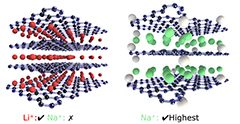Dec 22 2014
An engineering team from the Kansas State University has unveiled certain vital properties of graphene oxide, which can enhance flexible batteries made of sodium and lithium-ions.
 This graphic shows graphene oxide produced at 900 degrees C (left) and 500 degrees C (right).
This graphic shows graphene oxide produced at 900 degrees C (left) and 500 degrees C (right).
The engineering team comprised of assistant professor of mechanical and nuclear engineering, Gurpreet Singh, and a doctoral student in mechanical engineering, Lamuel David, India. Their research findings are published in an article in the Journal of Physical Chemistry titled “Reduced graphene oxide paper electrode: Opposing effect of thermal annealing on Li and Na cyclability."
Graphene oxide can be described as a defective and insulating form of graphene which when heated can be transformed into a conductor or a semiconductor. The engineering team worked with graphene oxide sheets to form flexible paper electrodes for sodium- and lithium-ion batteries.
They discovered that the amount of sodium stored by the paper electrodes was based on the distance from one layer to the next. It was possible to modify this distance by heating in ammonia or argon gas.
For instance, reduced graphene oxide (rGO) sheets created using high temperature tend to possess near zero sodium capacity. On the other hand, rGO sheets produced at 500°C possess the maximum capacity.
"The observation is important because graphite, which is a precursor for making graphene oxide, has negligible capacity for sodium and has long been ruled out as viable electrode for sodium-batteries," Singh said. "Graphite is the material of choice in current lithium-ion batteries because the interlayer spacing is just right for the smaller size lithium ions to diffuse in and out."
This breakthrough research is the first of its kind where flexible paper fully made up of graphene oxide sheets was capable of charging and discharging with the aid of sodium-ions for over 1,000 cycles. The electrolyte in the cells was sodium perchlorate salt dissolved in ethylene carbonate.
"Most lithium electrode materials for sodium batteries cannot even last for more than a few tens of charge and discharge cycles because sodium is much larger than lithium and causes enormous volume changes and damage to the host material," Singh said. "This design is unique because the distance between individual graphene layers is large enough to allow fast insertion and extraction of the sodium ions, thanks to the oxygen and hydrogen atoms that prevent sheets from restacking."
The research team was also involved in studying the mechanical activities of the electrodes composed of rGO sheets. They did this by measuring the strain needed to split apart the electrodes. Using videography, they revealed that the crumpled graphene oxide papers were capable of sustaining large strains prior to failing.
"Such measurements and study of failure mechanisms are important for designing long-life batteries because you want the electrode to be able to expand and contract repeatedly without fracture for thousands of cycles, especially for larger non-lithium metal-ion batteries," Singh said. "These days, almost every one is using crumpled graphene as either the conducting agent or elastic support or both."
Before the team embarked on this research, they had demonstrated bulk synthesis of few-layer-thick sheets of molybdenum disulfide early this year. They also demonstrated how molybdenum disulfide/graphene composite paper had the capacity to act as a high-capacity electrode for sodium-ion battery. The researchers relied on graphene as an electron conductor for the molybdenum disulfide sheets and noticed that graphene remained very inactive toward sodium.
In their recent research, the capacity of lithium in the rGO improved with increasing rGO synthesis temperature realizing maximum value for sample created at 900°C in comparison to sodium.
"It is only now we realize that sodium capacity of graphene, or rGO, is dependent on its processing temperature," Singh said. "The rGO specimens in our previous study were prepared at 900°C."
The lead researcher stated that the study of sodium and non-lithium batteries is crucial due to many reasons. Since the spotlight has shifted from vehicles to static energy storage systems and large vehicles, it is important that stationary batteries are safe, cost-effective, and eco-friendly. The solution was in sodium which is available in plenty, thus making it the probable candidate for substituting lithium-ion batteries.
Using nanotechnology, the team was able to explore and devise materials that can accumulate sodium-ions reversibly and at the same time without causing any damage. Their solution lay in graphene oxide.
"We would like to perform fundamental studies to understand the origins of first cycle loss, voltage hysteresis, and capacity degradation that are common to metal-ion battery anodes prepared from 2D layered crystals such as transition metal chalcogenides, graphene," Singh said.
The researchers will continue their work to find other nanomaterials that as of now, have been eliminated as probable battery electrodes like silicon-nitrogen based ceramics and boron nitride sheets.